simulate this circuit – Schematic created using CircuitLab
Figure 1. Simple circuit with multiple ammeters and voltmeters. Figure 2. The same circuit with the resistor and LED positions swapped.
In Figure 1 we have a simple 12 V battery powering an LED. The LED needs about 10 mA to light brightly and at that current will have nearly 2 V across it. That means we need a resistor to drop the other 10 V. From Ohm's Law we can calculate that \$ R = \frac {V}{I} = \frac {10}{0.01} = 1~k\Omega \$ so that's what we've got. We'll put three ammeters into the circuit to monitor current at every junction.
Conventional current flow is from '+' to '-'. This was decided before the electron was discovered by J. J. Thompson in 1897 and we still use it.
- 10 mA will be leave the battery and go through AM1 to R1. AM1 will read 10 mA.
- The 10 mA will continue through AM2 to D1. AM2 will read 10 mA.
- The 10 mA will flow through D1 and through AM3. AM3 will read 10 mA.
- The 10 mA will return to the battery.
If we use another dodgy water / hydraulic analogy, we can replace the battery with a hydraulic pump, pumping water clockwise around the circuit through a hydraulic motor. Clearly whatever water leaves the pump must return to it. There is no current lost.
There is, however, pressure loss. The pressure on the top of the circuit will be the pump pressure, the pressure at the bottom will be zero. The pressure at the junction between R1 and D1 will be somewhere in between.
In the same way the voltage at the top will be 12 V, the voltage at the bottom will be 0 V and the voltage at R1 / D1 will be somewhere in between.
It doesn't matter where in the circuit you put the control valve / resistor. The resultant current will be the same.
What's important is voltage drop across the component and not the voltage of any one terminal with respect to either of the battery terminals. As far as the LED is concerned having its terminals at 0 and 2 V is the same as having them at 10 and 12 V or 3.2 and 5.2 V, etc.
